Multi-Analytical Characterization and Radiocarbon Dating of a Roman Egyptian Mummy Portrait
Abstract
:1. Introduction
2. Materials and Methods
2.1. The Case Study
2.2. Multispectral Reflectography and Fibre-Optics Reflectance Spectroscopy (FORS)
2.3. Laser Scanning Microprofilometry
2.4. Spectral-Domain Optical Coherence Tomography (Sd-OCT)
2.5. Radiocarbon Dating by Accelerator Mass Spectrometry (AMS)
3. Results
3.1. Multispectral Reflectography and Fibre-Optics Reflectance Spectroscopy (FORS)
3.2. Laser Scanning Microprofilometry
3.3. Spectral-Domain Optical Coherence Tomography
3.4. Radiocarbon Dating
4. Discussion and Conclusions
Supplementary Materials
Author Contributions
Funding
Acknowledgments
Conflicts of Interest
References
- Borg, B.E.; Most, G.W. The Face of the Elite. Arion 2000, 8, 63–96. [Google Scholar]
- Walker, S. Ancient Faces: Mummy Portraits from Roman, Egypt; Taylor & Francis: Didcot, UK, 2000. [Google Scholar]
- Freccero, A. Fayum Portraits: Documentation and Scientific Analyses of Mummy Portraits Belonging to Nationalmuseum in Stockholm; Acta Universitatis Gothoburgensis: Gothenburg, Sweden, 2000. [Google Scholar]
- Doxiadis, E. The Mysterious Fayum Portraits: Faces from Ancient Egypt; Harry, N., Ed.; Abrams: New York, NY, USA, 1995. [Google Scholar]
- Thompson, D.L. Mummy Portraits in the J. Paul Getty Museum; Getty Publications: Malibu, CA, USA, 1982. [Google Scholar]
- Parlasca, K.; Seemann, H. Augenblicke: Mumienporträts und Ägyptische Grabkunst aus Römischer Zeit; Schirn Kunsthalle: Frankfurt, Germany, 1999. [Google Scholar]
- Delaney, J.K.; Dooley, K.A.; Radpour, R.; Kakoulli, I. Macroscale multimodal imaging reveals ancient painting production technology and the vogue in Greco-Roman Egypt. Sci. Rep. 2017, 7, 1–12. [Google Scholar] [CrossRef] [Green Version]
- Ramer, B. The Technology, Examination and Conservation of the Fayum Portraits in the Petrie Museum. Stud. Conserv. 1979, 24, 1–13. [Google Scholar]
- Corcoran, L.H.; Svoboda, M. Herakleides: A Portrait Mummy from Roman Egypt; Getty Publications: Malibu, CA, USA, 2010. [Google Scholar]
- Petrie, W.M.F. Hawara, Biahmu, and Arsinoe, Field & Tuer; The Leadenhall Press: London, UK, 1889. [Google Scholar] [CrossRef]
- Barr, J.; ten Berge, C.M.; van Daal, J.M.; van Oppen de Ruiter, B.F. The Girl with the Golden Wreath: Four Perspectives on a Mummy Portrait. Arts 2019, 8, 92. [Google Scholar] [CrossRef] [Green Version]
- The J. Paul Getty Museum. Available online: https://www.getty.edu/museum/conservation/APPEAR/index.html (accessed on 28 May 2021).
- Mazurek, J.; Svoboda, M.; Schilling, M. GC/MS Characterization of Beeswax, Protein, Gum, Resin, and Oil in Romano-Egyptian Paintings. Heritage 2019, 3, 119. [Google Scholar] [CrossRef] [Green Version]
- Dunand, F.; Lichtenberg, R. Mummies and Death in Egypt; Cornell University Press: Ithaca, NY, USA, 2006. [Google Scholar]
- Hillyer, L. The conservation of a group of painted mummy cloths from Roman Egypt. Stud. Conserv. 1984, 29, 1–9. [Google Scholar]
- Miliani, C.; Daveri, A.; Spaabaek, L.; Romani, A.; Manuali, V.; Sgamellotti, A.; Brunetti, B.G. Bleaching of red lake paints in encaustic mummy portraits. Appl. Phys. A 2010, 100, 703–711. [Google Scholar] [CrossRef]
- Bierbrier, M.L. Portraits and Masks: Burial Customs. In Roman Egypt; British Museum Press: London, UK, 1997. [Google Scholar]
- Borg, B. Lo sguardo interiore. In Memoria di sé nell’Egitto Romano, in “Roma, la Pittura di un Impero”; Skira: Milan, Italy, 2009; pp. 66–75. [Google Scholar]
- Federico, G. The Fragment of the Canvas Portrait of the Greek-Roman Egypt Conserved at the Papyrological Institute of Florence: Intervention and Restoration Project. Master’s Thesis, Opificio delle Pietre Dure—Firenze Scuola di Alta Formazione e di Studio, Firenze, Italy, 2020–2021. [Google Scholar]
- Striova, J.; Dal Fovo, A.; Fontana, R. Reflectance imaging spectroscopy in heritage science. La Riv. Del Nuovo Cim. 2020, 43, 515–566. [Google Scholar] [CrossRef]
- Striova, J.; Ruberto, C.; Barucci, M.; Blažek, J.; Kunzelman, D.; Dal Fovo, A.; Pampaloni, E.; Fontana, R. Spectral Imaging and Archival Data in Analysing Madonna of the Rabbit Paintings by Manet and Titian. Angew. Chem. 2018, 57, 1–6. [Google Scholar] [CrossRef] [Green Version]
- Moon, T.; Schilling, M.R.; Thirkettle, S. A note on the use of false-color infrared photography in conservation. Stud. Conserv. 1992, 37, 42–52. [Google Scholar] [CrossRef]
- Kruse, F.A.; Lefkoff, A.B.; Boardman, J.W.; Heidebrecht, K.B.; Shapiro, A.T.; Barloon, P.J.; Goetz, A.F.H. The spectral image processing system (SIPS)—Interactive visualization and analysis of imaging spectrometer data. Remote Sens. Environ. 1993, 44, 145–163. [Google Scholar] [CrossRef]
- Dal Fovo, A.; Striova, J.; Pampaloni, E.; Fedele, A.; Morita, M.M.; Amaya, D.; Grazzi, F.; Cimò, M.; Cirrincione, C.; Fontana, R. Rubens’ painting as inspiration of a later tapestry: Non-invasive analyses provide insight into artworks’ history. Microchem. J. 2020, 153, 104472. [Google Scholar] [CrossRef]
- Carcagnì, P.; Daffara, C.; Fontana, R.; Gambino, M.C.; Mastroianni, M.; Mazzotta, C.; Pampaloni, E.; Pezzati, L. Optical micro-profilometry for archaeology. Opt. Methods Arts Archaeol. Int. Soc. Opt. Photonics 2005, 5857, 58570F. [Google Scholar]
- Chiari, M.; Barone, S.; Bombini, A.; Calzolai, G.; Carraresi, L.; Castelli, L.; Czelusniak, C.; Fedi, M.E.; Gelli, N.; Giambi, F.; et al. LABEC, the INFN ion beam laboratory of nuclear techniques for environment and cultural heritage. Eur. Phys. J. Plus 2021, 136, 1–28. [Google Scholar] [CrossRef]
- Fedi, M.E.; Cartocci, A.; Manetti, M.; Taccetti, F.; Mandò, P.A. The 14C AMS facility at LABEC, Florence. Nucl. Instrum. Methods Phys. Res. Sect. B Beam Interact. Mater. At. 2007, 259, 18–22. [Google Scholar] [CrossRef]
- Mook, W.G.; Streurman, H.J. Physical and chemical aspects of radiocarbon dating. In Proceedings of the First International Symposium 14 C and Archaeology, Groningen 1981; Council of Europe: Strasbourg, France, 1981; Volume 8, pp. 31–55. [Google Scholar]
- Manning, M.P.; Reid, R.C. CHO systems in the presence of an iron catalyst. Ind. Eng. Chem. Process. Des. Dev. 1977, 16, 358–361. [Google Scholar] [CrossRef]
- Fedi, M.E.; Bernardoni, V.; Caforio, L.; Calzolai, G.; Carraresi, L.; Manetti, M.; Taccetti, F.; Mandò, P.A. Status of sample combustion and graphitization lines at INFN-LABEC, Florence. Radiocarbon 2013, 55, 657–664. [Google Scholar] [CrossRef]
- Why radiocarbon measurements are not true calendar ages. Available online: https://c14.arch.ox.ac.uk/calibration.html (accessed on 25 May 2021).
- Reimer, P.J.; Austin, W.E.; Bard, E.; Bayliss, A.; Blackwell, P.G.; Ramsey, C.B.; Talamo, S. The IntCal20 Northern Hemisphere radiocarbon age calibration curve (0–55 cal kBP). Radiocarbon 2020, 62, 725–757. [Google Scholar] [CrossRef]
- Cheilakou, E.; Troullinos, M.; Koui, M. Identification of pigments on Byzantine wall paintings from Crete (14th century AD) using non-invasive Fiber Optics Diffuse Reflectance Spectroscopy (FORS). J. Archaeol. Sci. 2014, 41, 541–555. [Google Scholar] [CrossRef]
- Cloutis, E.; MacKay, A.; Norman, L.; Goltz, D. Identification of historic artists’ pigments using spectral reflectance and X-ray diffraction properties I. Iron oxide and oxy-hydroxide-rich pigments. J. Near Infrared Spectrosc. 2016, 24, 27–45. [Google Scholar] [CrossRef]
- Aceto, M.; Agostino, A.; Fenoglio, G.; Idone, A.; Gulmini, M.; Picollo, M.; Delaney, J.K. Characterisation of colourants on illuminated manuscripts by portable fibre optic UV-visible-NIR reflectance spectrophotometry. Anal. Methods 2014, 6, 1488–1500. [Google Scholar] [CrossRef]
- Bisulca, C.; Picollo, M.; Bacci, M.; Kunzelman, D. UV-Vis-NIR reflectance spectroscopy of red lakes in paintings. In Proceedings of the 9th International Conference on NDT of Art, Jerusalem, Israel, 25–30 May 2008; pp. 25–30. [Google Scholar]
- Kakoulli, I.; Radpour, R.; Lin, Y.; Svoboda, M.; Fischer, C. Application of forensic photography for the detection and mapping of Egyptian blue and madder lake in Hellenistic polychrome terracottas based on their photophysical properties. Dye. Pigment. 2017, 136, 104–115. [Google Scholar] [CrossRef]
- Fonseca, B.; Patterson, C.S.; Ganio, M.; MacLennan, D.; Trentelman, K. Seeing red: Towards an improved protocol for the identification of madder-and cochineal-based pigments by fiber optics reflectance spectroscopy (FORS). Herit. Sci. 2019, 7, 1–15. [Google Scholar] [CrossRef]
- Feller, R.L. Artist’s Pigments: A Handbook of their History and Characteristics; Cambridge University Press and National Gallery of Art: London, UK, 1986; Volume 2. [Google Scholar]
- Delaney, J.K.; Ricciardi, P.; Glinsman, L.D.; Facini, M.; Thoury, M.; Palmer, M.; de La Rie, E.R. Use of imaging spectroscopy, fiber optic reflectance spectroscopy, and X-ray fluorescence to map and identify pigments in illuminated manuscripts. Stud. Conserv. 2014, 59, 91–101. [Google Scholar] [CrossRef] [Green Version]
- Freccero, A. Wax Painting, Encausto and Ganosis. Ancient Painting Techniques with Wax as a Binding Medium and Methods of Surface Coating. Bachelor’s Thesis, Institute of Conservation Göteborg University, Göteborg, Sweden, 1997. [Google Scholar]
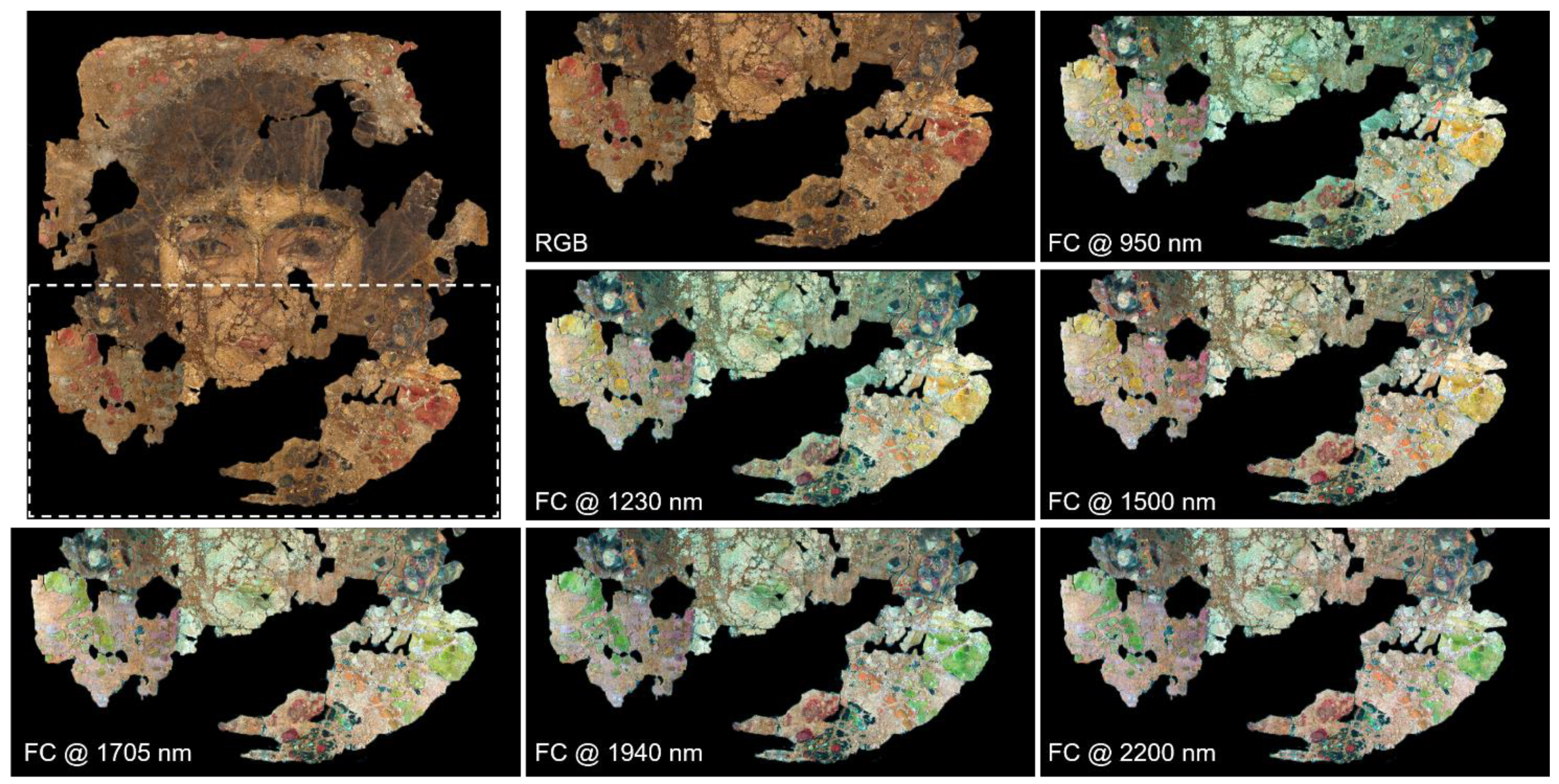
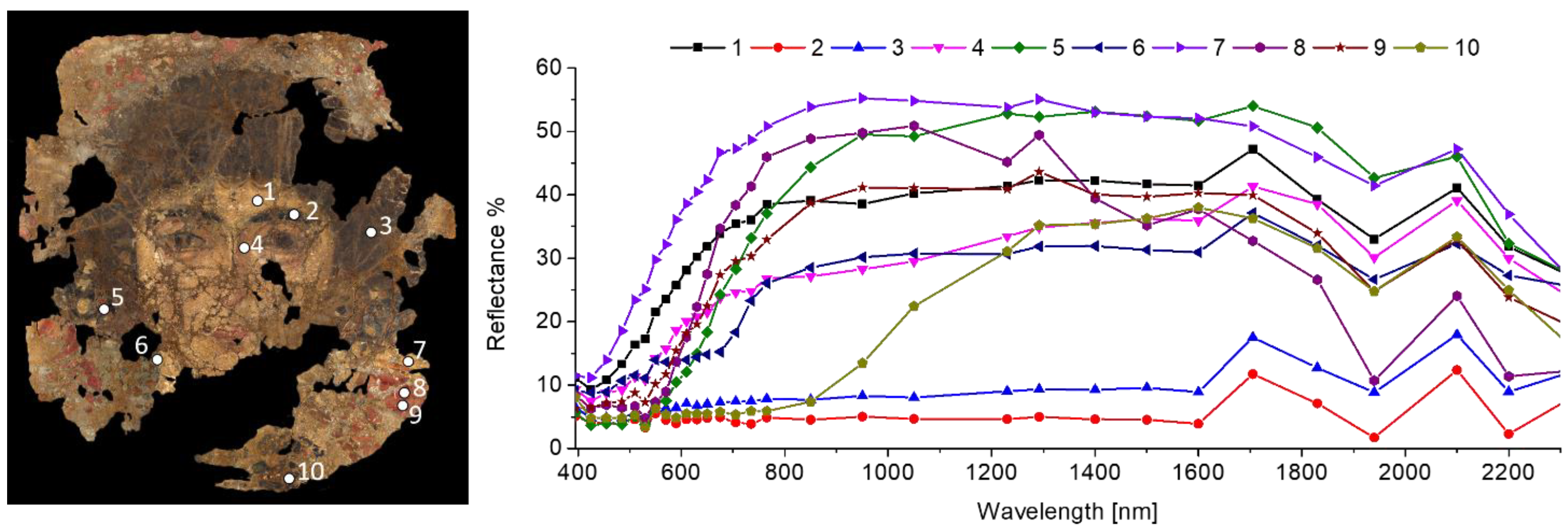
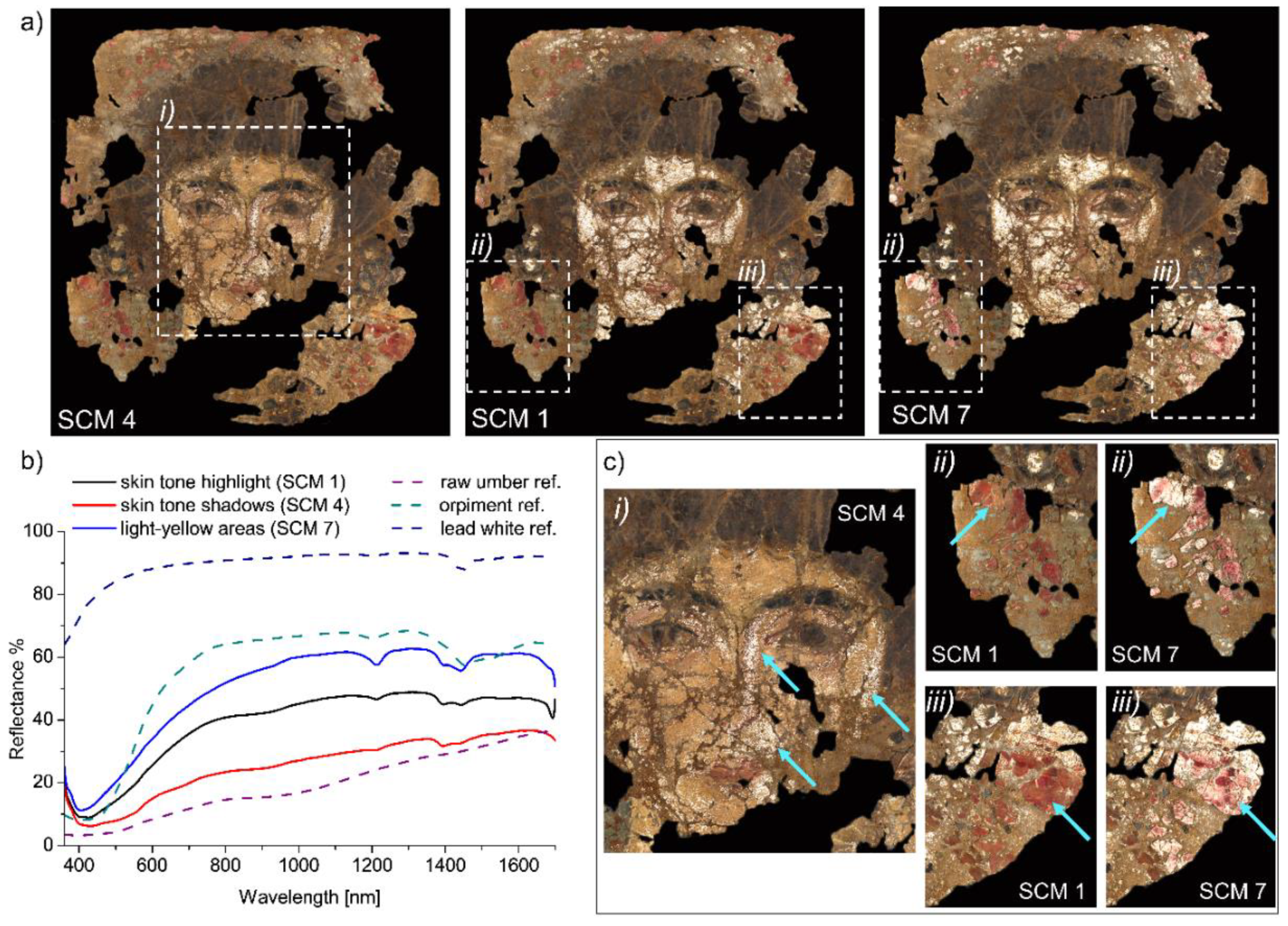
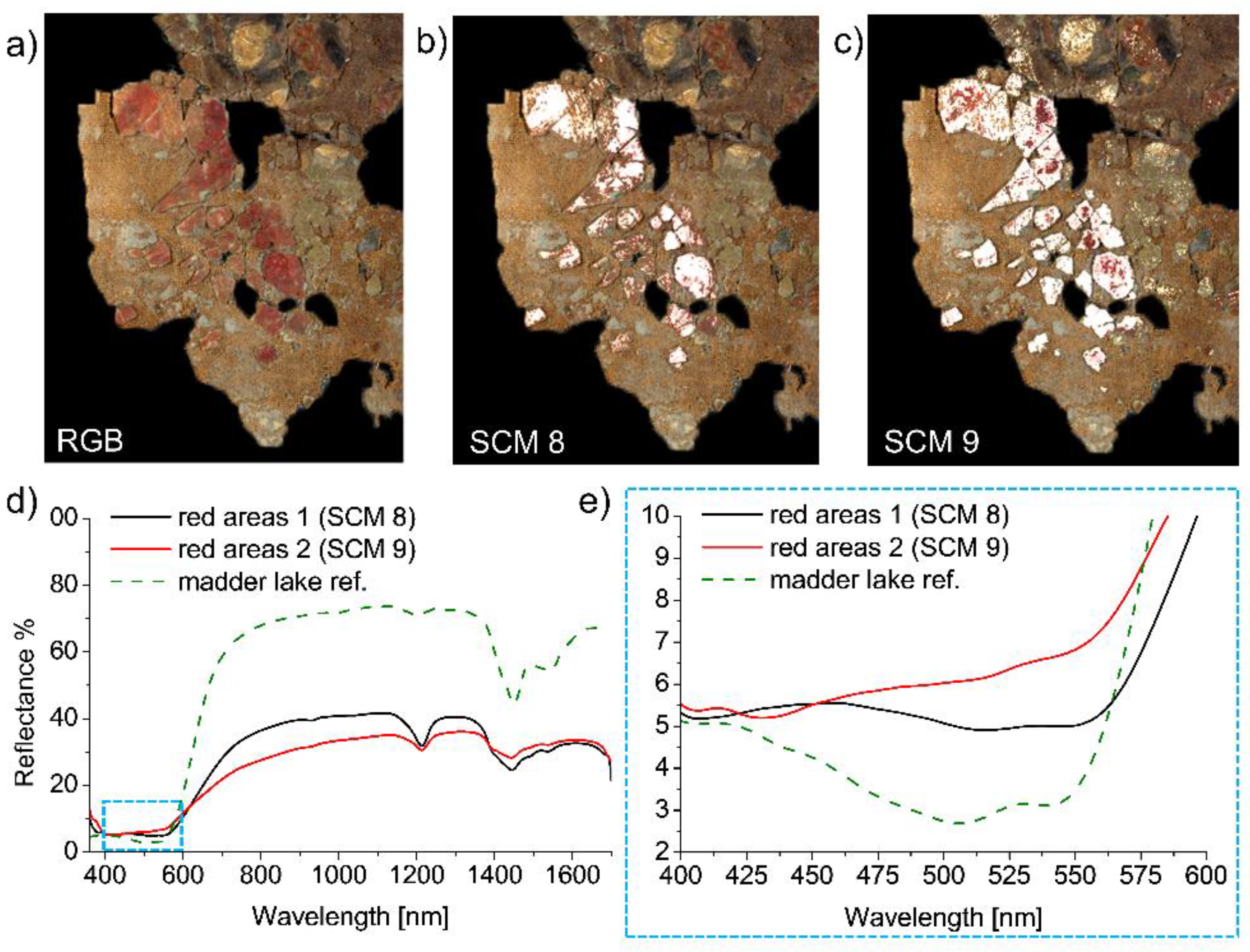
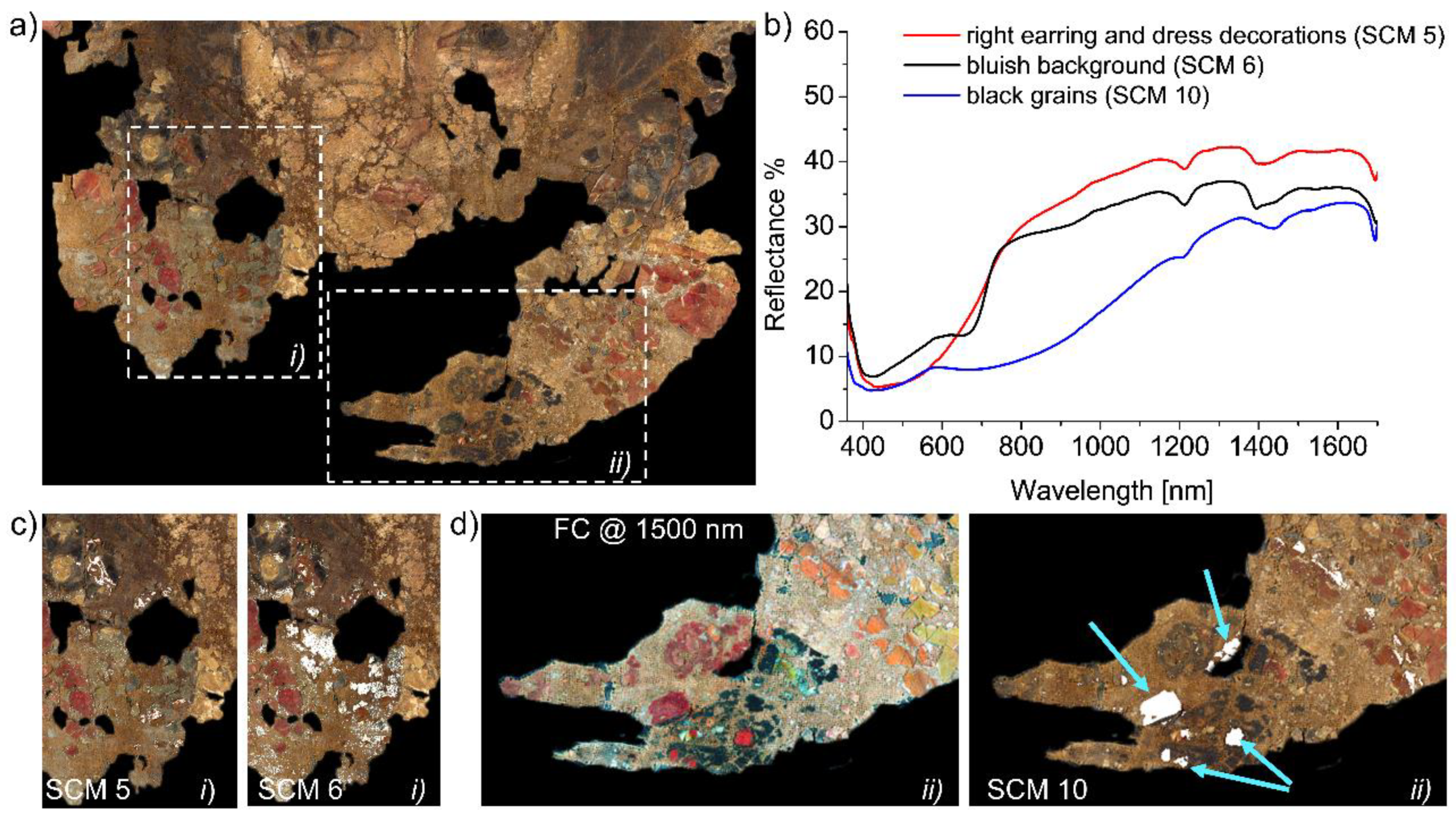
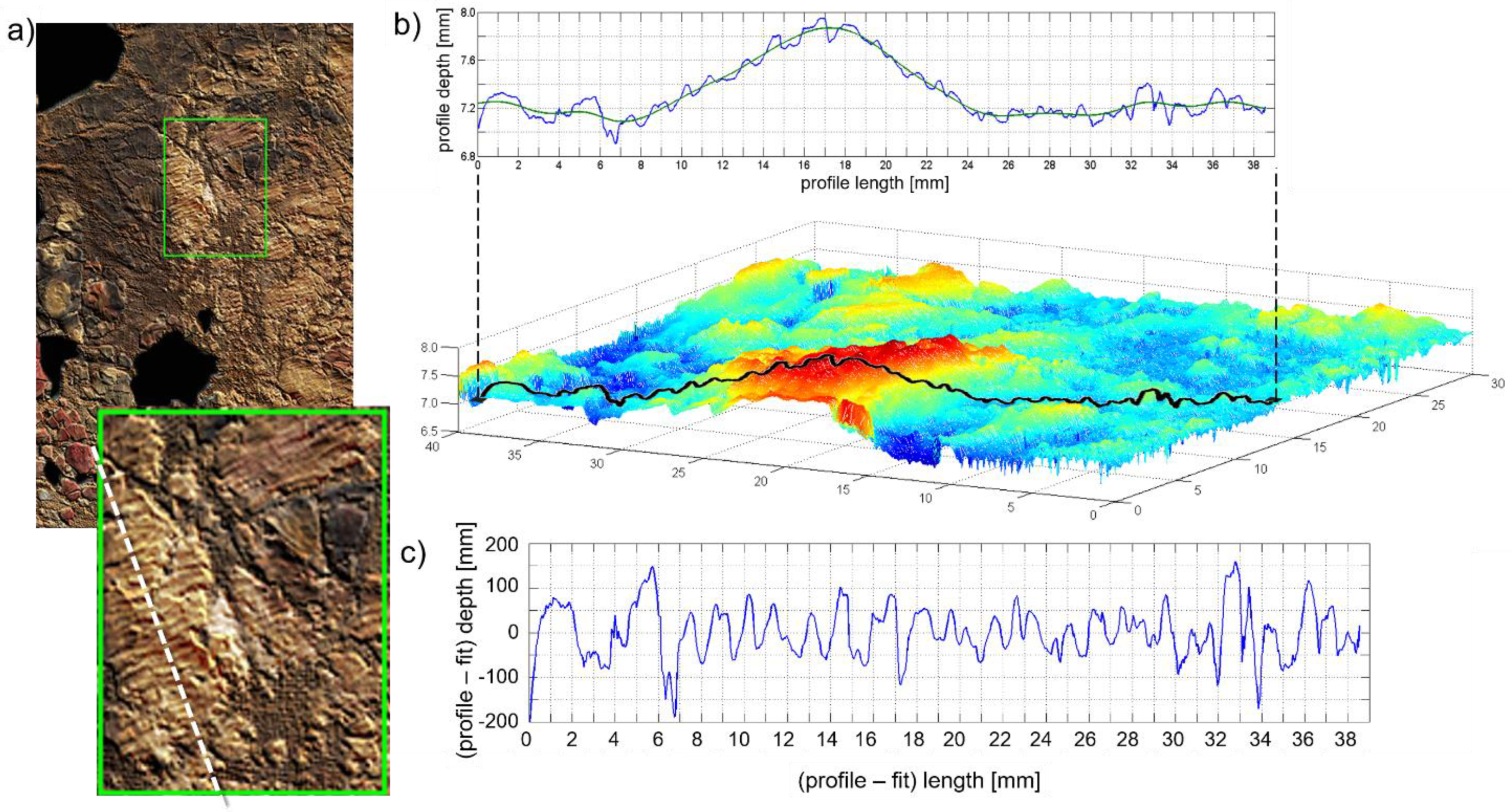
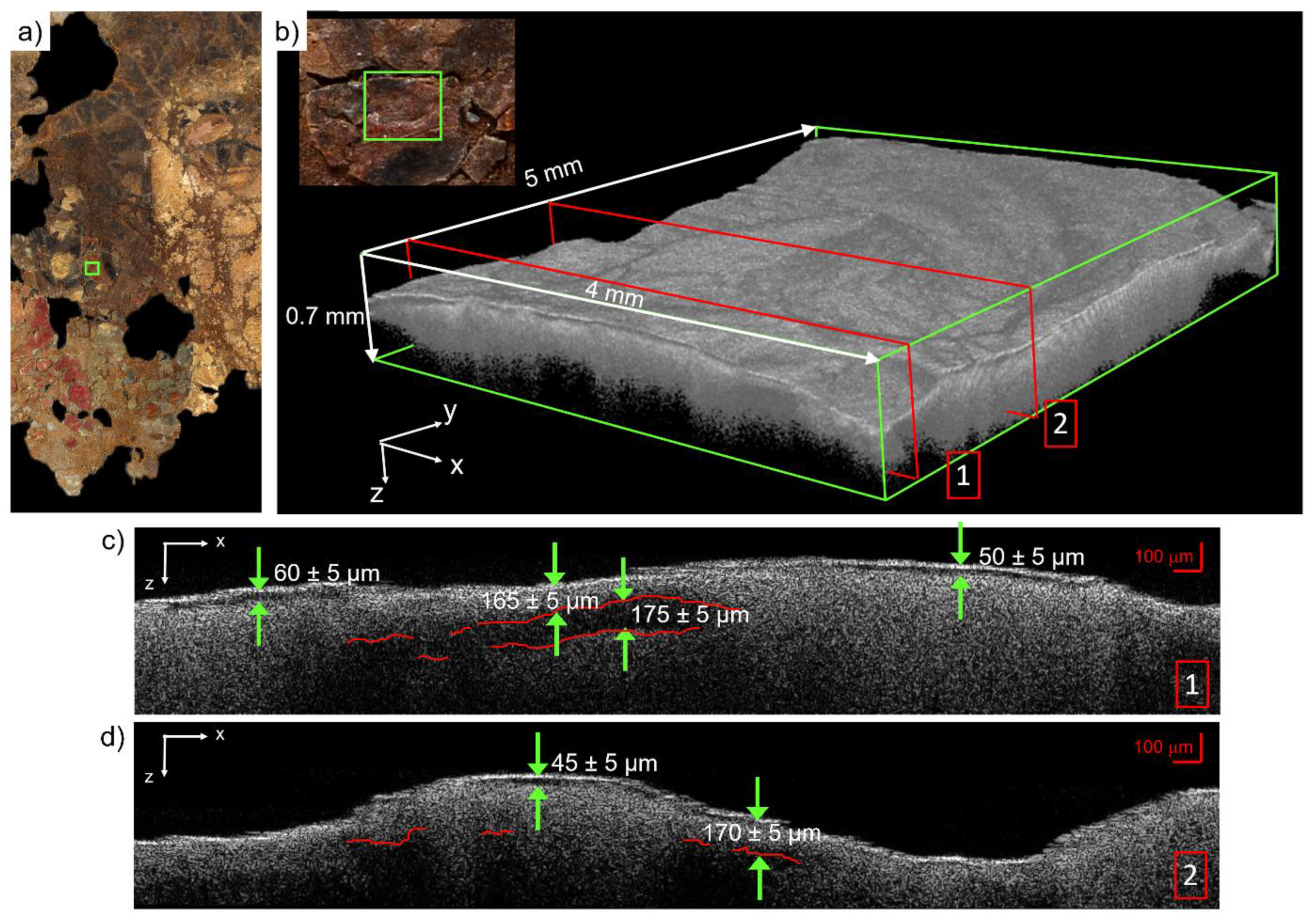
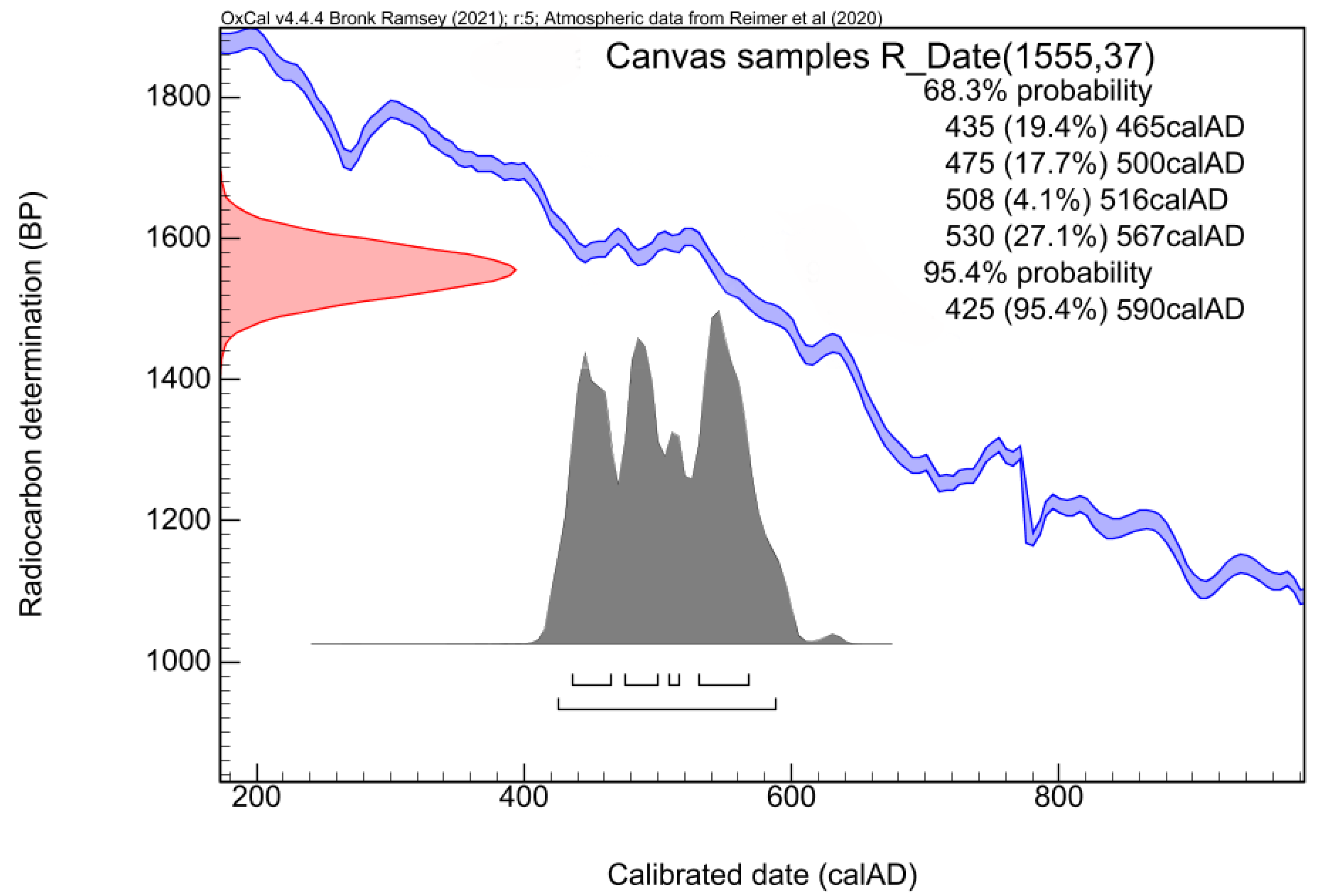
| 14C Conc. (pMC) | TRC (Years BP) | Calibrated Age (68% Prob.) | Calibrated Age (95% Prob.) | |
|---|---|---|---|---|
| Canvas samples | 82.40 ± 0.38 | 1555 ± 37 | 435–570 AD | 425–590 AD |
Publisher’s Note: MDPI stays neutral with regard to jurisdictional claims in published maps and institutional affiliations. |
© 2021 by the authors. Licensee MDPI, Basel, Switzerland. This article is an open access article distributed under the terms and conditions of the Creative Commons Attribution (CC BY) license (https://creativecommons.org/licenses/by/4.0/).
Share and Cite
Dal Fovo, A.; Fedi, M.; Federico, G.; Liccioli, L.; Barone, S.; Fontana, R. Multi-Analytical Characterization and Radiocarbon Dating of a Roman Egyptian Mummy Portrait. Molecules 2021, 26, 5268. https://doi.org/10.3390/molecules26175268
Dal Fovo A, Fedi M, Federico G, Liccioli L, Barone S, Fontana R. Multi-Analytical Characterization and Radiocarbon Dating of a Roman Egyptian Mummy Portrait. Molecules. 2021; 26(17):5268. https://doi.org/10.3390/molecules26175268
Chicago/Turabian StyleDal Fovo, Alice, Mariaelena Fedi, Gaia Federico, Lucia Liccioli, Serena Barone, and Raffaella Fontana. 2021. "Multi-Analytical Characterization and Radiocarbon Dating of a Roman Egyptian Mummy Portrait" Molecules 26, no. 17: 5268. https://doi.org/10.3390/molecules26175268
APA StyleDal Fovo, A., Fedi, M., Federico, G., Liccioli, L., Barone, S., & Fontana, R. (2021). Multi-Analytical Characterization and Radiocarbon Dating of a Roman Egyptian Mummy Portrait. Molecules, 26(17), 5268. https://doi.org/10.3390/molecules26175268








